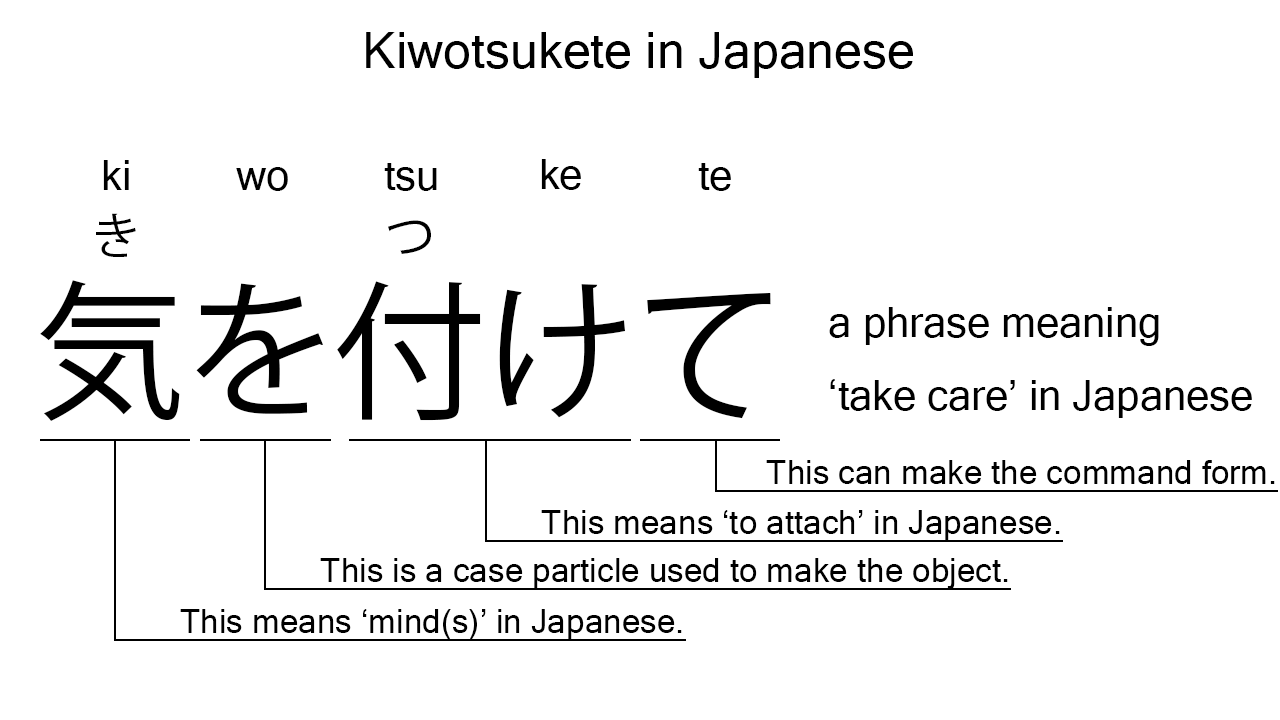What does “kiwotsukete” mean in Japanese?
Native speakers say “kiwotsukete” often to mean ‘take care’ in Japanese. Perhaps, some Japanese learners know this phrase as it is sometimes used in Japanese conversations. In this blog post, however, I will explain it in detail based on its grammatical components. And also, I will explain how to use it through example sentences. My explanations would help Japanese learners understand “kiwotsukete” more clearly. Then, let’s get started!
Contents
- Definition and meanings of “kiwotsukete”
- What does “kiwotsukete” literally mean in Japanese?
- Summary
Definition and meanings of “kiwotsukete”
Let me start with the definition and meanings of “kiwotsukete”.
- kiwotsukete – 気を付けて (きをつけて) : a phrase meaning ‘take care’ or ‘be careful’ in Japanese.
Native speakers use this phrase to mean ‘take care’ or ‘be careful’ in Japanese. The usage is very similar to those of the English phrases, I think.
The definition and meanings are not that difficult. To understand this phrase more clearly, however, let me explain its grammatical components in detail, one by one.
What does “kiwotsukete” literally mean in Japanese?
“Kiwotsukete” consists of the following four components:
- ki – 気 (き) : a noun meaning ‘mind’, ‘mood’, ‘feeling’, ‘heart’, or such in Japanese.
- wo – を : a case particle used to make the object word in a sentence. In the phrase, this is used after “ki” to make the object.
- tsuke – 付け (つけ) : one conjugation of the verb, “tsukeru”, which means ‘to attach’, ‘to append’, ‘to add’, or such in Japanese. It has been conjugated for the better connection with its following word.
- te – て : a conjunctive particle used after a verb, adjective, or auxiliary verb to make its te form. In the phrase, this is used after “tsuke” to make its te form, “tuske te”. In Japanese, te-formed words have some important roles. One of them is become command forms.
From these four components, we can understand that “kiwotsukete” can work like the command form and literally means ‘attach the mind’ in Japanese. This literal interpretation is not completely in line with the actual meanings of the phrase, but still understandable, I think. In Japanese, “take care” and “be careful” can be expressed by the phrase which means “attach the mind (to the object)”.

When we meet new Japanese phrases, we should check their grammatical components in detail to understand their meanings clearly and deeply. In many cases, components tell us a lot about the meanings of the phrases they form. Actually, here, we could get the better understanding of “kiwotsukete” through the detailed check above.
So far, I’ve explained the definition and meanings of “kiwotsukete” together with its grammatical components. Then, let me explain how to use it through the example sentences below.
Example #1: how to say “take care” in Japanese
kenkou ni kiwotsukete – 健康に気を付けて (けんこうにきをつけて)
Take care of your health.
Below are the new words used in the example sentence.
- kenkou – 健康 (けんこう) : a noun meaning ‘health’ in Japanese.
- ni – に : a case particle used to say in which direction an action goes. In the example, this is used after “kenkou” to indicate the object which the listener should take care of.
This is a typical usage of “kiwotsukete”. In this example, it works as a part of the commonly-used phrase, “kenkou ni kiwotsukete”, which means ‘take care of your health’ in Japanese.
The example sentence doesn’t contain any word referring to “you”, but its meaning can be understood as ‘take care of your health’. Japanese sentences often lack words referring to a person or people. We need to guess to whom those sentences are directed from the situation and context. In the example, the sentence is obviously directed to the listener. So, we can understand its meaning as ‘take care of your health’. This is one of the reasons Japanese is considered as a high-context language, I think.
Example #2: another usage of “kiwotsukete”
kuruma no unten ni kiwotsukete – 車の運転に気を付けて (くるまのうんてんにきをつけて)
Be careful driving.
Below are the new words used in the example sentence.
- kuruma – 車 (くるま) : a noun meaning ‘car’ in Japanese. This can also work as plural. Learn more about Japanese plural.
- no – の : a case particle joining two nouns. Normally, the first one can work as a modifier to describe the second. In the example, this works to join “kuruma” and “unten”. The formed phrase literally means ‘car driving’ in Japanese.
- unten – 運転 (うんてん) : a noun meaning ‘driving’ in Japanese.
This is another typical usage of “kiwotsukete”. When we want to say “be careful” in Japanese, this phrase is a very good option.
Summary
In this blog post, I’ve explained the definition and meanings of “kiwotsukete” in detail based on its grammatical components. And also, I’ve explained how to use it through example sentences. Let me summarize them as follows.
- kiwotsukete – 気を付けて (きをつけて) : a phrase meaning ‘take care’ or ‘be careful’ in Japanese. This phrase is the command form which literally means ‘attach the mind’ in Japanese. This literal interpretation is not completely in line with the actual meanings, but still understandable, I think. In Japanese, “take care” and “be careful” can be expressed by the phrase which means “attach the mind (to the object)”.
Hope my explanations are understandable and helpful for Japanese learners.